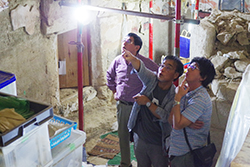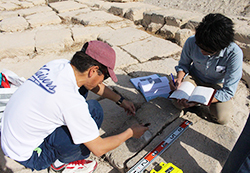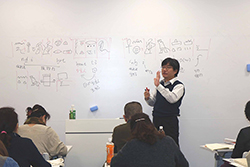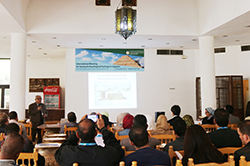For 6 days from the 22nd to the 28th February 2018, “Comprehensive Seminar on Cultural Heritages 2017” was hosted.
This seminar was held with researchers and specialists involved in activities on the forefront of fields regarding the conservation of cultural properties. The objective being the pursuit of extensive studies on the topic of cultural heritage. With this being the 5th seminar hosted, the contents and plan was partially changed this time as we incorporated practical training and actual implementation in addition to the lectures.
We received 25 applications from university students, graduate students and working publics etc., all of whom held various intentions, many also participated from outside the Kansai area.
In the lectures, we discussed the laws and institutions related to cultural heritages and the scientific studies of cultural heritages, upon the common understanding of issues regarding what cultural heritage meant for mankind and the reasons behind preserving cultural heritages. Furthermore, we learnt the general knowledge surrounding cultural properties and cultural heritages including historical structures and archaeological sites, metal cultural properties and international cooperation etc. In the lecture incorporating practical training through contact with actual artifacts, participants learned about the traditional techniques and materials of arts and crafts, such as Washi (Japanese paper) and textiles, lacquer artifacts.
In addition, in the lecture on the topic of polychromatic cultural properties, after learning about polychromatic materials employed in ancient times, worked on the practice of drawing patterns of the Nara period (8th Century) with actual colorant materials. Also, in the lecture on biological degradation, we divided into groups and conducted practical exercises regarding examination methods and countermeasures of harmful insects, pests and mold.
Also, we learned about the generation of 3-D models of cultural properties using the method of structure form motion (SfM), and also hands on learning on the handling and packaging methods of cultural properties.
Moreover, the participants visited Gangoji Institute for Research of Cultural Property, Todaiji Museum, Office of the Shosoin treasure home, National Museum of Ethnology. At the Gangoji Institute, we visited the restoration labs and got the explanation about the restoration methods of various cultural properties. At the office of the Shosoin treasure home, we visited the facility in charge of analyzing and restoring of various treasures, and also we were also able to observe the ancient warehouse structure called Azekura and enquire about the preservation methods that ensured the longevity of these treasures.
At the National Museum of Ethnology, we learned about preservation and management of certain materials through a lecture. Then we visited the storage and insecticide treatment facilities, and also we were able to learn practically about the inspection of the museum collection. In addition, we got the information of the methods of environmental management, packaging materials, and proper storage boxing while closely observing actual equipment and materials.
In the questionnaire distributed to the participants, there are comments like “we were able to achieve a deeper understanding about the conservation of cultural heritage not only through the lecture but also through the practical session,” or “it was good experience because there were many of the lectures and the practices that could not be able to get through lectures in university.”













































